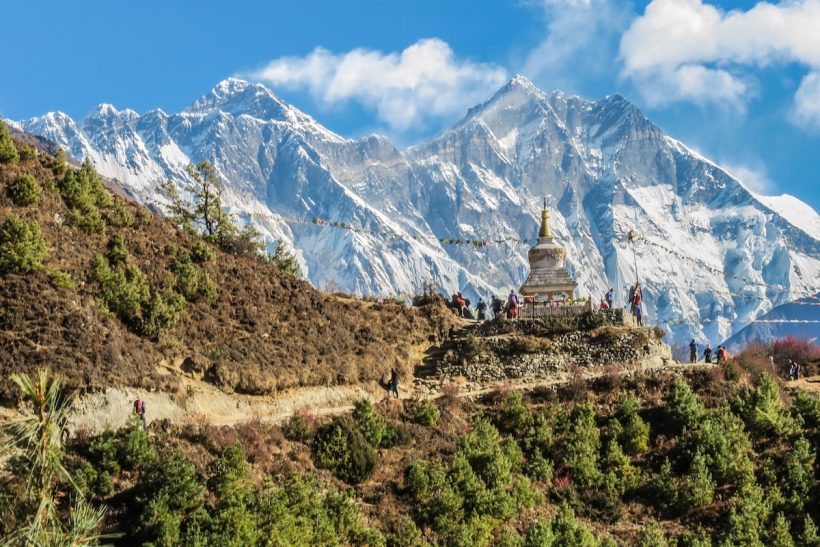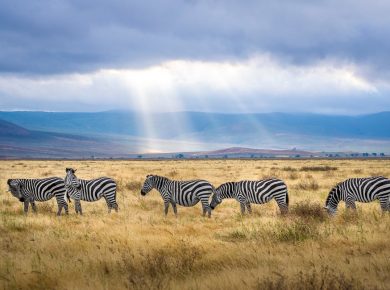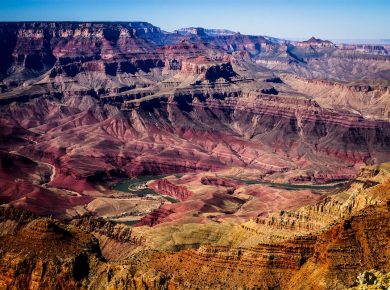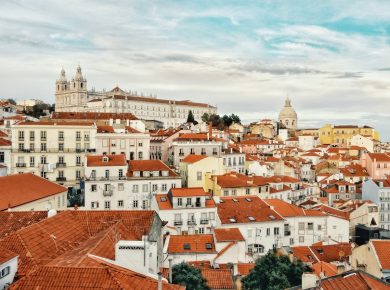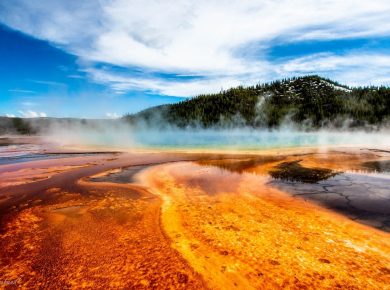Nepal is a land full of endless adventure and possibilities. Experience a wholly unique culture, its people famous for their kindness, hospitality, and toughness for living in such a harsh environment. Whether your mission is to see nature, try tasty food, or get to know a new culture, you’ve done well by choosing this country.
For such a small country, Nepal is packed with different climate zones! The weather can change drastically from one region to the next, making planning a visit into an ordeal.
The best months to visit Nepal are March and April when the weather conditions are optimal for all of the outdoor activities and visiting the national parks.
The season you choose can make or break your experience. Even if you don’t plan on climbing Everest, you don’t want to spend half the trip stuck in your hotel dodging thunderstorms with downpours. Temperatures range from hot to super hot. You may be used to heat back home, but the hot season has proven dangerous for non-locals.
As a result, visitors plan their trips to coincide with the dry season. The problem then becomes avoiding fellow tourists who came at the same time. One feels peak season’s presence in places like Kathmandu, where the center’s hotels stay packed. If you want to avoid the heat and rain, you might end up paying extra for it.
This article assesses the average weather and tourist season trends to determine the best month to visit Nepal for good weather and low prices. To do this, we will look at two metropolitan areas: Kathmandu near the country’s center, and Biratnagar in the southeast. Additionally, we analyze tourism trends in these areas to determine how traffic reflects in pricing.
Table of Contents
Average Temperature In Nepal
Nepal is a country of extremes, and its temperatures are no exception! In the cities, summers are consistently hot. Winters, though rarely below freezing, still get chilly. Weather in the mountainous areas (of which Nepal is covered) is wild and unpredictable. However, here we’ll focus on the two cities.
Surprisingly, Biratnagar is the hottest in spring due to frequent heat waves. Visit in April or May and you might burn alive with average highs reaching 101°F and lows of 81°F. Luckily, these temperatures are the peak and the summer months are comparatively cooler, with July ranging from 92°F to 80°F and August from 90°F to 79°F.
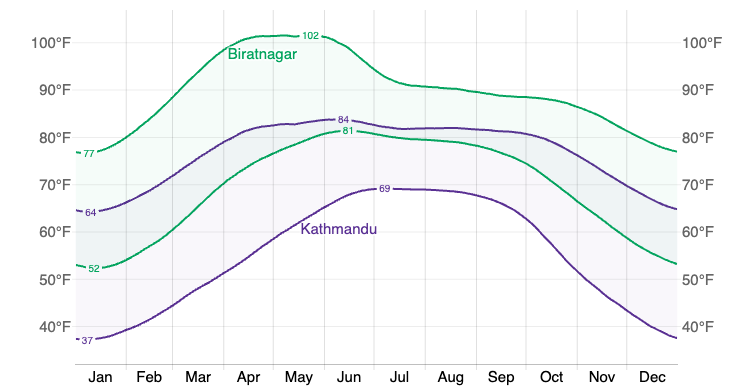
Kathmandu’s spring temperatures are also high, but lower than Biratnagar’s and stay consistent throughout the summer. From April through the end of September, the highs never surpass the lower 80s, and lows fluctuate between the lower and upper 60s.
If traveling in the winter, don’t expect icy conditions like on the Himalayas peaks. These months are relatively mild for temperatures. Biratnagar still feels summer-like, with January getting highs of 78°F and lows of 53°F. Kathmandu gets weather more closely resembling a traditional winter with January highs of 65°F and 38°F.
Spring is the hottest season in Nepal. The fall months are unusually high, too. Even as winter sets in, temperatures in the two cities can climb up to the lower 80s during the daytime.
Daily Chance Of Precipitation In Nepal
Like other South and Southeast Asian countries, it’s better to categorize Nepal’s weather into two seasons: dry and rainy. Its temperatures don’t follow the same patterns as in Europe and North America, so precipitation patterns more accurately define the seasons here.
The country’s rainy season is in full swing by June and ends in September. Levels of rainfall vary throughout the period but over half the days of each month get some kind of precipitation. And when it rains, it usually pours. mid-June sees a peak for rainfall in Kathmandu and Biratnagar. The latter gets the heaviest rainfall with over 10 inches in June. Kathmandu still gets 7.3 though.
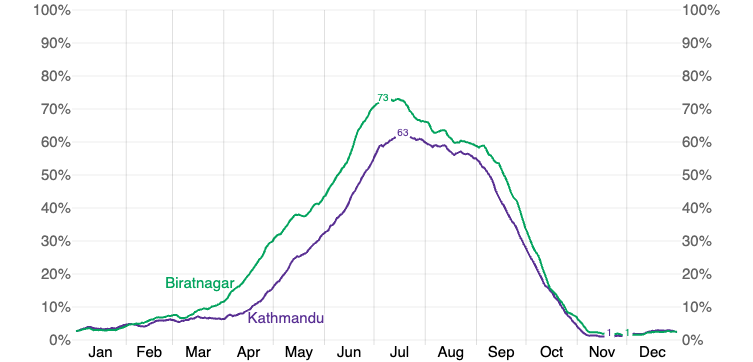
Thunderstorms are also commonplace in the spring and summer months making city walks treacherous. Clear skies are a rarity during Nepalese summers, too. Your view of Mt. Everest in the distance behind Kathmandu’s skyline is almost sure to be covered by grim-looking storm clouds.
The dry season lasts from October through May. Most of the season has a 0% chance of rainfall, but one to three rainy days per month is normal. The skies are mostly clear.
Humidity Comfort Levels In Nepal
Like the rainy and dry seasons, Nepal has a definite time for humidity. The onset of the wet season sees a huge change in the country’s atmosphere.
As if someone flipped a switch, the chance of humidity jumps from near zero to 100% in Biratnagar in spring. With temperatures reaching over 100°F, it feels even higher with the thick, muggy air weighing you down. Nepal’s humid season poses serious health threats to those not used to this type of weather.
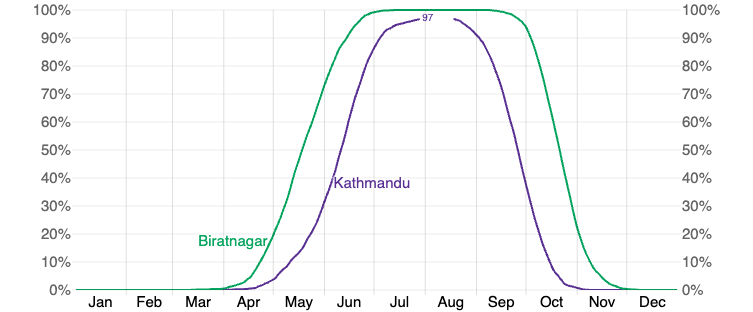
Kathmandu has a slightly lower humidity level along with lower temperatures, but the difference is minor. Visiting either place in the spring or summer months can be dangerous if you’re not prepared for such extreme heat. The humidity only amplifies this.
From November through February, the chance of humidity is 0%. Though traveling in this period will greet you with high temperatures, dry heat doesn’t feel as oppressive.
Best Time Of Year To Nepal For Great Weather
We’ve established that Nepal has wacky and sometimes hazardous weather. Does that mean you should avoid it? Certainly not! A lot of the severe conditions are limited to a certain part of the year, and the country is safe to visit for more than half the year. When is the best season to visit Nepal for great weather?
There are two factors used to decide the best months for weather called the “tourism score” and the “beach/pool score,” respectively. The first is used to determine how pleasurable outdoor activities like sightseeing tours are in a given month. Clear skies and temperatures between 65°F and 80°F are the criteria here.
Due to their temperature difference, Biratnagar and Kathmandu have slightly different trends. The best months for Kathmandu are May and October. These months rest on the periphery of the wet season and enjoy a beautiful combination of warm temperatures and clear skies, resulting in the score 8.3 at both points.
Biratnagar is too hot in the early spring and fall, resulting in a lower score. However, mid-February and mid-November are a bit milder in the city. Still outside of the wet season and having relatively tame temperatures in the 70s and 80s, it scores highest in November at 8.7 and 8.1 in February.
Both cities score well on the beach/pool score, too. Biratnagar ranks 8.0 in mid-March and October. Kathmandu’s best time is mid-May, scoring 6.6 around this time. Though you’d be remiss to find beaches in landlocked Nepal, there are several resorts where you can enjoy the hot weather at an outdoor pool!
Best Time Of Year To Visit Nepal For Low Prices
Scoring discounts on a Nepal trip can prove challenging, but relentless searches for deals are often rewarded! Due to its location, there aren’t any direct flights to Kathmandu from the USA. However, a few airlines like Qatar Airways, Kuwait Airways, and Air India offer stopover packages that connect Americans with Nepal as quickly as possible.
Airfare from North America is pricey. Expect to pay roughly $1,500 to fly in dry months like November or February. If you’re lucky, you can find a flight in these months for about $1,000.
If the weather doesn’t bother you, airfare prices drop drastically in low-season months like June and July. You can make the trip for $700, but there may not be much to see or do at this time.
Though you’ll spend a lot on your flight, accommodations have possibilities for savings no matter what season you visit! A mid-range hotel room for 2 in Kathmandu can range from $30 to $60 per night in November and June. The prices don’t fluctuate significantly, making the country an easy place to plan spontaneously.
Hostels are another popular option, many of them maintaining high standards of security and cleanliness. If you don’t mind sharing a room with some strangers, you can sleep for as little as $4 per night and meet some interesting fellow travelers in the process.
Peak Travel Season In Nepal
The short window of perfect hiking weather that spans October and November makes up Nepal’s peak season. Tourists of all kinds flood the country in these two months, heading to base camps, hiking trails, and city centers. If visiting during this period, some parts of your trip will prove costly. However, Nepal is affordable for most tourists once they get inside!
Skies are almost always clear and temperatures, though hot, aren’t as extreme as other times of the year. It’s the one part of the dry season that isn’t dangerously hot. Because of the good hiking conditions, even remote areas are full of tourists, making the accommodation hunt a challenge.
Despite warnings from travel sites, hotels in Kathmandu are plentiful and reasonably priced. Check sites like Booking.com, where high-rated hotel rooms go for as low as $23. In Europe and North America, accommodations typically raise their prices the closer you get to your travel date. Here, however, many places keep the same prices year-round.
Unfortunately, you’re likely to compensate for these low accommodation prices when you book your ticket. Flight prices in peak season rarely drop below $1,000 and often sit around $1,500. Deals like $700 tickets are hard to come by, but they exist! Keep your eyes peeled and observe how prices fluctuate.
Shoulder Travel Season In Nepal
The spring months of March and April make up Nepal’s brief shoulder season. Weather conditions are conducive to travel and prices are relatively low. Temperatures are at an all-time high in these two months. However, heat waves only affect the lowlands. If visiting the Mt. Everest base camp, you’ll need winter clothes!
You won’t get rained on much in March. April, on the other hand, is usually the start of the wet season. If traveling in the second half of the month, you’ll notice an uptick in rain showers.
Wildlife lovers are advised to travel during this period, as it’s the best time for spotting local fauna, such as tigers, rhinos, and red pandas. Trekking is another popular activity during this time of year. The icy mountain passes are mostly safe to cross, making opportunities for impressive views.
You’re most likely to encounter tourist crowds in busy trekking areas or remote cities with lower temperatures like Bhaktapur with its stunning Buddhist temples.
Airfare costs vary little from peak season. You may not have to pay $1,500 and up, but prices below $1,000 are scarce. However, just like in peak season there’s a huge selection of cheap, high-quality rooms to rent all over the country! From Kathmandu hotels to shelters along hiking trails, you can sleep comfortably for $5-30 per night.
Low Travel Season In Nepal
Nepal’s off-season coincides with the wet season which lasts from June to September. Travel costs are at their lowest, but travel hazards are at their highest!
It doesn’t rain every single day but expect a great amount of it if visiting in the summer. The best, most romantic views of Everest and other mountain areas are obstructed by gray storm clouds. Tourists are advised to avoid the mountains due to monsoons that often result in landslides, leech infestations, and mud that no expensive hiking boots or off-road vehicles can conquer.
December through February make up the other part of the off-season. The rain ceases, but the winter hits high-elevation areas like a train. Even Kathmandu gets quite chilly at night. National parks close some mountain trails, and accommodation owners also close their doors for the season. However, the southern lowlands stay very warm and there are several national parks to take advantage of!
The period is full of deals waiting to be snatched up. Flights from the USA often range from $700-$1,000 during the off season. However, bargain hunters have reported deals as low as $400. Some accommodations in remote areas close down for the off-season, but there won’t be a shortage. Mid-range hotels will still welcome you for the low rates they offer year-round!
Best Months For Travel To Nepal
To make sure your Nepalese adventure is a magical time, it’s crucial to book at the right time! Extreme weather is frequent, but it doesn’t last the whole year, making it easy to plan around.
If you plan on spending any time in the mountains or national parks, avoid the wet season of June through September. Rain overwhelms the country’s infrastructure and you’re likely to get stuck somewhere during your journey. The winter months are also tough if the mountains are your goal. Most trails are too icy and impossible to pass.
The shoulder season months of March and April, though hot, have nice conditions for all of the activities that bring people to Nepal! The trekking areas are at a much higher elevation, and therefore are much cooler. Humidity and rain are low at this time.
